Background
Maritime transport has been recognized as the most fuel efficient, cost effective and environment friendly transport system. Carrying goods on water is cheaper, more reliable and less polluting than by road or rail. All developed countries have based their development on their efficient maritime infrastructure and policies. Maritime sector plays a vital role in the trade and commerce of any country, whether it is internal trade or external trade.
India is blessed with a long coast line of over 7,500 km and home to 14,500 km of navigable waterways, of which 5,200 km of major rivers and 485 km of canals are conducive to movement of mechanized vessels. It has 13 major ports, 10 intermediate ports and over 180 minor ports on the East and West coast of India, besides having 5 internal National Waterways. Out of the 13 Major ports, 6 are on the East coast and the remaining on the West coast (Fig. 1). Similarly among the minor ports there are about 50 minor ports on the East coast and the balance are on the West coast of India. Traditionally the West coast ports have been handling industrial, and finished products along with the petroleum products, whereas the East coast ports have been handling the bulk and mineral products.
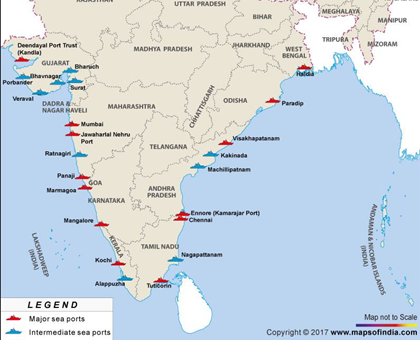
Major and Intermediate Sea Ports of India
India's 14,500 km of navigable waterways comprise of rivers, canals, backwaters, creeks, etc, of which only 4382 km of waterways have been utilised. About 55 million tonnes of cargo is being moved annually by Inland Water Transport (IWT), a fuel - efficient and environment -friendly mode. Its operations are currently restricted to a few stretches in the Ganga- Bhagirathi- Hooghly rivers (NW-1), the Brahmaputra (NW-2), the Barak river, the rivers in Goa, the backwaters in Kerala, coastal waters in Mumbai and the deltaic regions of the Godavari - Krishna rivers (Fig. 2). Besides these organized operations by mechanized vessels, country boats of various capacities also operate in various rivers and canals. Substantial quantum of cargo and passengers are transported in this unorganized sector as well. There is a huge potential waiting to be unlocked through the development of these inland waterways.
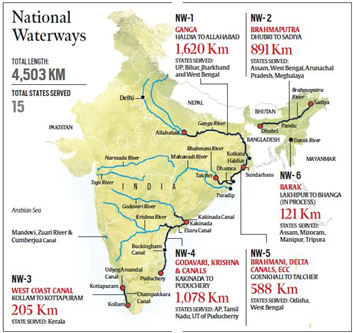
Inland Waterways of India
The ocean waves and marine and river currents provide an abundant source of green renewable energy. India's long coastline of around 6000 km boasts of a potential to generate 40,000 MW of wave energy as a primary estimate. Although, the energy available is comparatively less than what is available in more northern and southern latitudes, this might be compensated through proper resource mapping and intelligent selection of efficient design of the harnessing device. On the other hand, total identified potential of tidal energy is about 9000 MW on West Coast Gulf of Cambay (7000 MW), Gulf of Kutch (1200 MW) and in East Coast the Ganges Delta in the Sunderbans in West Bengal for small scale tidal power development estimates the potential in this region to be about 100 MW. In addition, there are inland rivers and irrigational channels with potential current speed of more than 1.0 m/s (2 knots) that can generate electricity through efficient design and installation of current turbines.
The technological challenges arising out of the Indian coastal and inland waterways are different to that of European, United States and Chinese coastal and inland waterways. In India, more goods travel by congested road and rail networks. This slows down the cargo movement and increase the cost of logistics which is currently around 15% of GDP. Fig. 3 gives the comparative modal mix for transportation by rail, road, water and air for India, China, US and Europe. As per a report in Business Standard, India can save more than $50 billion annually if the logistic cost is brought down to less than 10% of GDP. Though water transport has been cost effective, and should have been the prime mode of transport given the present geographical and demographical advantage, it should be noted with concern that only about 7% (Fig. 4) of the freight moves by the coastal ships and less than 0.50% moves by the inland waterways (Fig. 5). Other countries such as China have an enviable percentage of 46% by coastal waterways and 8.3% by inland waterways. Similar figure for United States is 14% and 8.3% and Europe is 7% and 43%. As per the World Bank study in 2017, the percentage of freight movement on inland waterways in India is a mere 0.5% of total freight movement compared to 8.7% in neighbouring China, 7% in Europe and 8.3% in USA. The same study shows that the cost of transportation of 1 tonne of freight over 1 km is Rs. 2.28 for road and Rs. 1.41 for railways. The same value for inland waterways is Rs. 1.15 only (Fig. 6). The dependence on the road and rail sector for freight movement has lead to this high the logistic cost.
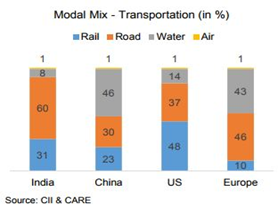
Modal Mix - Transportation
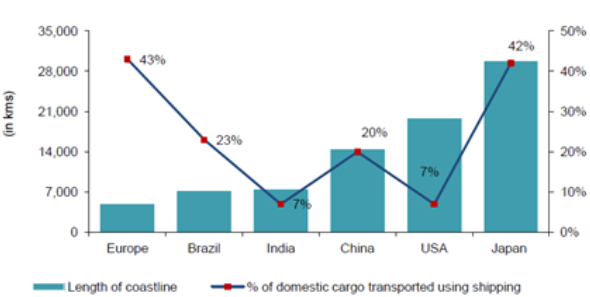
Comparison of coastal shipping penetration in movement of domestic cargo (2012)
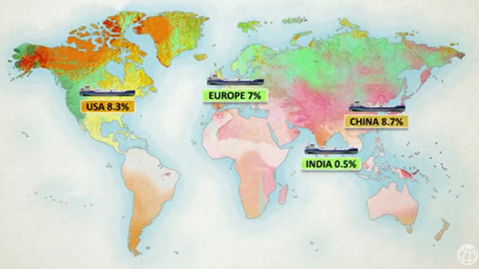
Freight movement on inland waterways across countries. (Courtesy World Bank 2017)
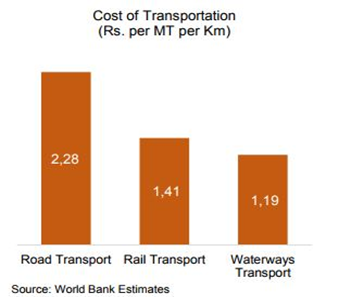
Cost of Transportation in Rs. per MT per Km
